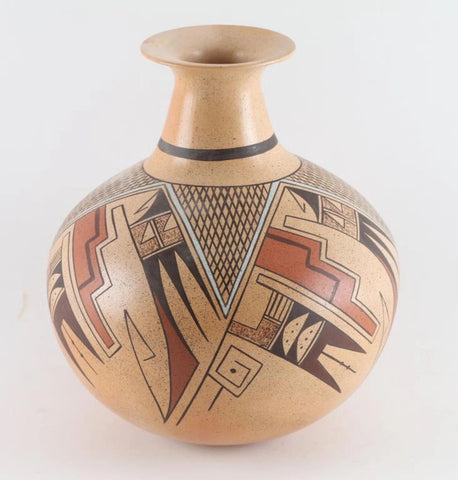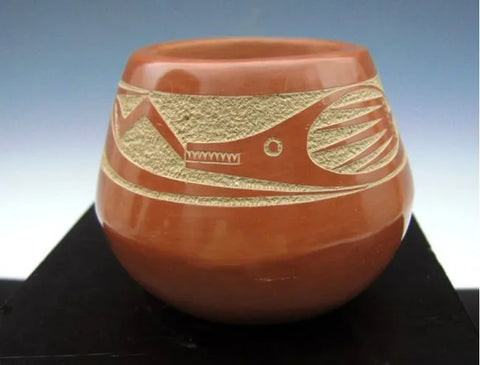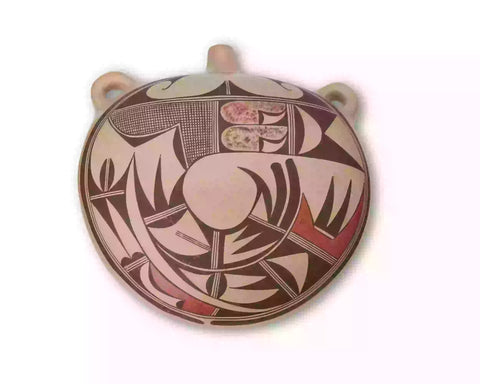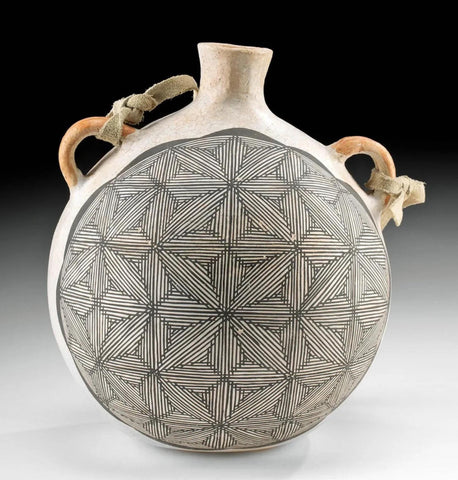
Native American, Historic Diegueno Small San Diego Pottery Plain Ware Cooking Bowl, #1030
$ 260.00
Native American,
Historic Diegueno
Small San Diego Pottery Plain Ware Cooking Bowl,
Found at Vallecito, San Diego
Description: Native American, Historic Diegueno Small San Diego Pottery Plain Ware Cooking Bowl, Found at Vallecito, San Diego County, Calif. in 1941.
Dimensions: 8.25 x 8 x 4.5 inches
Condition: As found, has one small barrly visable crack on upper edge of lip, other than this, it is in excellent condition for its age and use.
Some back ground on the Diegueno Indians and Pottery Making;
Location: Extreme southern California, crossing the border to Mexico (San Diego County & western part of Imperial County)
Language: Hokan family
Population:
1770 estimate: 3,000
1910 Census: 800
The two dialects of the Diegueño separated them into northern and southern groups, the northern Ipai (e pi) and the southern Tipai (te pi). The Diegueño are also known as the Kumeyaay.
SETTLEMENTS
Diegueño settlements spread across southern California and northern Baja California (now Mexico). Diegueños lived on the coast, in the mountains, and in the desert. Some Diegueño bands moved around a lot as the seasons changed. There are signs that some groups had several campsites that they occupied at different times of the year. There may have been very few permanent villages.
Diegueño comes from the name of the first Spanish mission in California, San Diego. The more precise names of Ipai and Tipai are words from the native languages meaning people. The people themselves did not use any name to refer to the more than 30 clans that spoke the Ipai-Tipai dialects. They called themselves instead by the place where their clan lived.
Each small group or band had a clan leader who inherited his position from his father. The leader was supposed to know more about the customs and history of his people, and so be able to direct their ceremonies and advise them on clan matters.
HOUSES
How the houses were built depended on the location and how long they were going to be used. In the summer village, only shade and a windbreak were needed. A row of trees or a cave would provide this, or a one-sided, roofed shelter made of poles and brush.
Where a more substantial house was needed, a dome-shaped building was constructed. Poles arranged in a circle were bent in to meet in the middle. The frame was covered with brush. This was sometimes covered with thatch made of tule reeds and with earth. Inside, the floor was dug out slightly below ground level. Attached to the house was a single wall used as a windbreak for an outside working area. Diegueños living in the desert might use palm branches as thatch on their shelters. In the mountains, slabs of bark could be used for the walls.
Each family was responsible for its own shelter, and for rebuilding it when the group moved. Everyone worked together to build a ceremonial structure, which was usually a brush fence enclosing a round dance area. Villages also had sweat houses, smaller than the dwellings, used by the men who gathered in the evening to cleanse themselves.
FOOD
For most of the Diegueño, acorns were the main food. Some of the southern Tipai groups depended more on pods from the mesquite bush, which they pounded into flour in much the same way that the others pounded acorns into flour. Seeds of the sage, flax, and buckwheat plants were also ground into flour, and used to make mush and flat cakes.
In the spring, the women and girls gathered fresh greens such as watercress, clover, yucca stalks and roots, and the blossoms and buds of roses and several kinds of cactus. In some areas they found berries on manzanita and elderberry bushes, wild plums and cherries. Wild onion was used as a seasoning. The agave plant, which provided fibers from which sandals were made, was also used as food.
The Tipai who lived in the Imperial Valley were one of the few early California groups to plant some crops. They learned from people living to the east of them how to grow corn, beans, and melons. Even those who did some farming, however, still got most of their food by gathering wild plants.
Deer were scarce in Diegueño territory. Men who knew how to hunt deer were respected. It was an honor for a boy to be chosen to learn to be a hunter of big game like deer. Most of the meat used by the Diegueño came from small animals like rabbits, woodrats, and lizards. They also ate some snakes and insects, as well as birds such as geese, quail, and doves. Only those groups who lived near the ocean had fish in their diet, for there were not many rivers in Diegueño areas. For people who lived near San Diego Bay, fish and mollusks were main foods.
CLOTHING
Very little clothing was necessary in the southern California climate. Children and men usually wore no clothes. Men used a belt around their waist on which they could fasten things they needed to carry. Women wore an apron-like skirt, sometimes with just one piece in front, sometimes with a second piece in the back. Since women carried things in a net bag that hung from a strap around the forehead, they often wore a round woven cap to protect their heads from the strap.
When they needed to walk through thorny areas, both men and women wore sandals made from agave fibers. When the weather was cold, they put blankets or robes over their shoulders. The robes were made of rabbitskin or deerskin, or of willow bark pounded until it was soft.
TOOLS
Both baskets and pottery were used by the Diegueño for storing and cooking food. The pottery containers were made from a red clay mixed with crushed rock. The clay was rolled into long ropes, coiled into the desired shape, and fired in a hot oven.
Fibers of the milkweed and yucca plants were used to make string and cord. The cord was then knotted to make nets and carrying bags. Nets were used by the hunters to catch small animals and birds. They also used curved throwing sticks and bows and arrows to catch game.
Both nets and hooks were used by the coastal groups for catching fish. They had light rafts made from bundles of tule reeds bound together with cord, which allowed them to go out on the bay to fish.
TRADE
The many groups of Ipai and Tipai often traded with each other for items that were found in each other's territory. Those on the coast traded dried seafood, salt, and abalone shells to those who lived in the hills and desert regions. From them they got acorns, agave, mesquite beans, and gourds. Groups living in the Imperial Valley traded food to the mountain groups in exchange for granite, steatite (or soapstone), and red and black minerals used to make paint. Anyone who owned an eagle could trade its feathers, which were considered of great value.
Major trails crossed southern California, going from the Colorado River to the Pacific Ocean. Because of this, the Diegueño had contact with groups living further east, and with early explorers of the southwest. Trade with these groups, though not frequent, influenced the Diegueño culture.
CEREMONIES
A special area for dances was made by using brush to make a circular fence around a section of level ground. Eagles were often used in ceremonies. A village leader might own an eagle's nest and raise eaglets.
An important ceremony was the keruk, held in the fall to honor those who had died during the past year. The dancing lasted four to eight days. Dolls made to look as lifelike as possible were used to represent those who had died. When a leader died, a special Eagle Dance was held. Gourd or deer-hoof rattles were used to keep rhythm for the dancing. Source: factcards.califa.org/cai/Diegueno.html.
A History of Pueblo Pottery:
Pueblo pottery is made using a coiled technique that came into northern Arizona and New Mexico from the south, some 1500 years ago. In the four-corners region of the US, nineteen pueblos and villages have historically produced pottery. Although each of these pueblos use similar traditional methods of coiling, shaping, finishing and firing, the pottery from each is distinctive. Various clay's gathered from each pueblo's local sources produce pottery colors that range from buff to earthy yellows, oranges, and reds, as well as black. Fired pots are sometimes left plain and other times decorated most frequently with paint and occasionally with applique. Painted designs vary from pueblo to pueblo, yet share an ancient iconography based on abstract representations of clouds, rain, feathers, birds, plants, animals and other natural world features.
Tempering materials and paints, also from natural sources, contribute further to the distinctiveness of each pueblo's pottery. Some paints are derived from plants, others from minerals. Before firing, potters in some pueblos apply a light colored slip to their pottery, which creates a bright background for painted designs or simply a lighter color plain ware vessel. Designs are painted on before firing, traditionally with a brush fashioned from yucca fiber.
Different combinations of paint color, clay color, and slips are characteristic of different pueblos. Among them are black on cream, black on buff, black on red, dark brown and dark red on white (as found in Zuni pottery), matte red on red, and poly chrome a number of natural colors on one vessel (most typically associated with Hopi). Pueblo potters also produce un-decorated polished black ware, black on black ware, and carved red and carved black wares.
Making pueblo pottery is a time-consuming effort that includes gathering and preparing the clay, building and shaping the coiled pot, gathering plants to make the colored dyes, constructing yucca brushes, and, often, making a clay slip. While some Pueblo artists fire in kilns, most still fire in the traditional way in an outside fire pit, covering their vessels with large potsherds and dried sheep dung. Pottery is left to bake for many hours, producing a high-fired result.
Today, Pueblo potters continue to honor this centuries-old tradition of hand-coiled pottery production, yet value the need for contemporary artistic expression as well. They continue to improve their style, methods and designs, often combining traditional and contemporary techniques to create striking new works of art. (Source: Museum of Northern Arizona)
----------------
View the other items in my shop: http://www.etsy.com/shop/CulturalPatina?ref=shopsection_shophome_leftnav











